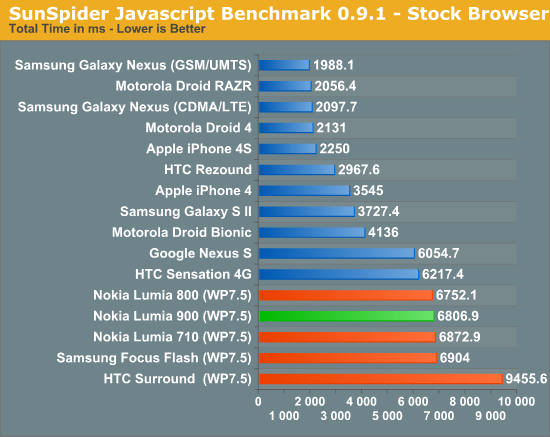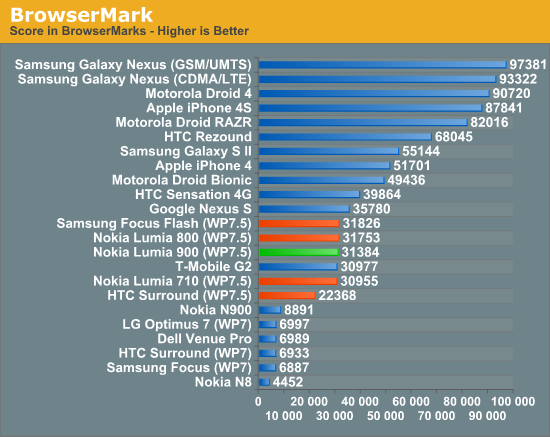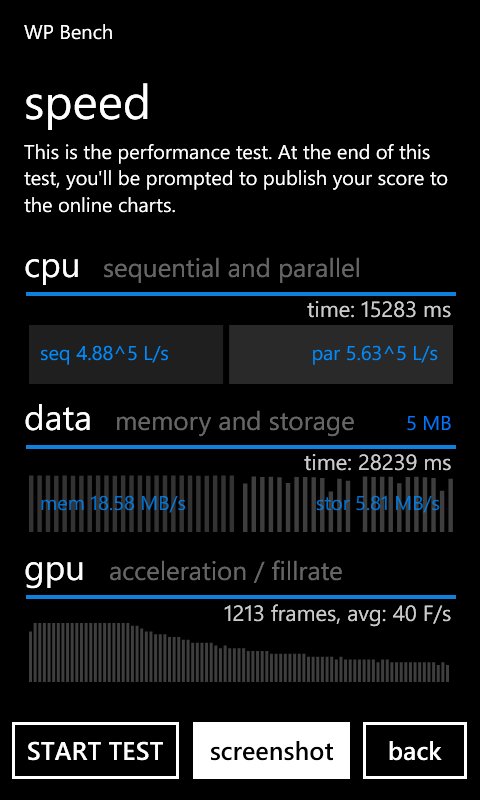Nokia Lumia 900 Review - Windows Phone with LTE
by Brian Klug on April 3, 2012 9:00 PM ESTPerformance
Performance on Windows Phone 7.5 at the moment tops out at almost the same place for virtually every handset. As I touched on before, the platform is still a Qualcomm-only party, and the name of the game is single core 45nm Snapdragon with Adreno 205 at the high end in the form of either MSM8x55, or for the Lumia 900 APQ8055 at 1.4 GHz.
I’ve already penned some thoughts on WP7’s current chassis spec, and in the future the specification will open up with the Tango update (which we’ve seen in the Lumia 610) to a lower-end configuration with MSM7x30 or MSM7x27A. Eventually Windows Phone will move onto dual core SoCs and possibly more vendors, but when and how that happens remains to be seen. The driving factors will undoubtably be both performance, but also improvements to things around the edges like 1080p video encode, decode, and power gains from a 28nm process geometry.
For now however let’s focus on the Lumia 900, which again is 1.4 GHz APQ8055 with 512 MB of LPDDR2. Benchmarking WP7.5 still is a pretty basic thing, since platform consistency somewhat obviates the need for many of the other big cross-platform benchmarks (this will change with Windows 8, however). For now that means our testing is limited primarily to assessing javascript performance with sunspider, browsermark, and WP Bench.


At this point all the most modern WP7 devices are still shipping with essentially the same SoC - 1.4 GHz 45nm MSM8x55/APQ8055. For comparison, the initial launch devices were 65nm QSD8x50 at 1 GHz. With the Tango update performance differences will start to be more of a thing for consumers to care about as it becomes possible to select a phone with a lower end SoC that still runs the Windows Phone UI at a decent clip (like the Lumia 610 we’ve handled). As a result, it isn't surprising at all to see the WP7.5 devices with the same exact SoC all clumped together and performing basically the same. In addition, though the WP7.5 IE JavaScript engine (Chakra) is a huge improvement upon the WP7 JScript engine, it still lags behind the competition on Android and iOS.














128 Comments
View All Comments
NeoteriX - Wednesday, April 4, 2012 - link
Google Maps:10 miles from a given point on a map.
...it's enough for all of Manhattan and nearly all of New York City.
Braumin - Wednesday, April 4, 2012 - link
My wife has the Lumia 800. It is a great phone, and the 900 just builds on that. Thank God they got rid of the magnetic door over the USB port.I'm excited to see what Nokia can bring to the table with WP8. I am a big fan of WP7.5, but I know it has some shortcomings. I can't see how those won't all be fixed with WP8 running on the Windows 8 kernel. Obviously Microsoft and Nokia don't want to talk about it (which is too bad) but for business reasons, it makes sense, but all the complaints about hardware should evaporate. Windows 8 already has support for high ppi displays, multicore, LTE, and everything else. Six months seems like a long time away.
The Lumia 900, especially at the price it is offered, should be a great phone for many people. I'll keep my old LG Optimus 7 until Apollo hits though.
j3ff86 - Wednesday, April 4, 2012 - link
174 nits of brightness is super pathetic. I bet Nokia uses a very aggressive ambient light sensor like they did on the N8 and E7. You can disable the light sensor on those phones with 3rd party software but I don't know if WP7 has similar apps.kyuu - Wednesday, April 4, 2012 - link
It's way beyond sufficient for indoor viewing... the only place you might need more brightness is outside in daylight. I guess you missed the part where Brian said that the clearblack feature was pretty effective at reducing glare/reflections and, due to that, the display was quite visible even in the outdoor daylight setting.If you can see the display clearly even in daylight, why would need or want more brightness? So you can drain the battery faster for no real benefit?
steven75 - Wednesday, April 4, 2012 - link
So it's only bad in real life situations where people use their phone? Ok, then.tipoo - Wednesday, April 4, 2012 - link
That's not what he said. The display has one of the lowest reflection indexes in a phone or tablet, its very good at reducing glare, so even if the brightness in absolute terms is lower, in real world use its pretty good since its not competing with the sun as much.ecuador - Wednesday, April 4, 2012 - link
Ehm... You have a N9 right there? Why don't you post a review? It is way too late now, but better late than never?tipoo - Wednesday, April 4, 2012 - link
It's an 800 with a dead OS. There's your review :)Beerfloat - Wednesday, April 4, 2012 - link
You mean it's an 800 but with another dead OS right :)But seriously, bring on the HTC One X review. Now there's a practically perfect smartphone.
tipoo - Wednesday, April 4, 2012 - link
Agreed, but I want the One X with Krait rather than Tegra 3, that one's not out yet.